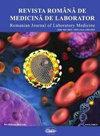MMP-2 and MMP-9 gene polymorphisms and risk of head and neck carcinomas
IF 0.5
4区 医学
Q4 MEDICINE, RESEARCH & EXPERIMENTAL
引用次数: 0
Abstract
Abstract Background: Head and neck carcinomas (HNC) account for a majority of ear, nose and throat tumours. They account for 6.3% of all incident malignancies and 6.2 % of all deaths from cancer in Romania in 2020, the fifth most common cancer in this Eastern Europe country. Aim of the study: The aim of our study was to investigate the association between two MMP-2 and MMP-9 promoter gene polymorphisms and head and neck cancer. Methods. We enrolled 142 subjects, 65 cancer patients, and 77 control subjects and tested them for MMP-2 -735 C/T and MMP-9 -1562 C/T polymorphisms by PCR-RFLP. Results. Comparison between cancer patients and controls demonstrated the presence of MMP-2 -735 C/T and MMP-9 -1562 C/T in head and neck malignant tumours, with OR = 2.206 (95% CI 1.058-4.599, P = 0.03) for MMP-2 and OR = 2.748 (95% C.I. 1.262-5.981, P=0.009) for MMP-9 gene polymorphism. This means that the presence of T allele could be a risk factor for head and neck cancer development. The analysis included a stratification of studied groups by age and gender. Conclusions. Both genotypes were associated with a significant risk for head and neck carcinomas in case of the presence of the T allele. MMP-2 -735 C/T (rs2285053) and MMP-9 -1562 C/T (rs3918242) gene polymorphism could be an important genetic marker for head and neck cancer susceptibility. This finding could be useful for genetic screening in head and neck carcinomas.MMP-2和MMP-9基因多态性与头颈癌的风险
背景:头颈癌(Head and neck carcinoma, HNC)在耳鼻喉肿瘤中占多数。到2020年,它们占罗马尼亚所有恶性肿瘤的6.3%和所有癌症死亡的6.2%,是这个东欧国家第五大常见癌症。研究目的:本研究的目的是探讨两种MMP-2和MMP-9启动子基因多态性与头颈癌的关系。方法。我们招募了142名受试者,65名癌症患者和77名对照,采用PCR-RFLP检测了他们的MMP-2 -735 C/T和MMP-9 -1562 C/T多态性。结果。头颈部恶性肿瘤患者与对照组比较发现MMP-2 -735 C/T和MMP-9 -1562 C/T存在,MMP-2基因多态性OR = 2.206 (95% CI 1.058 ~ 4.599, P= 0.03), MMP-9基因多态性OR = 2.748 (95% CI 1.262 ~ 5.981, P=0.009)。这意味着T等位基因的存在可能是头颈癌发展的一个危险因素。该分析包括按年龄和性别对研究群体进行分层。结论。在T等位基因存在的情况下,这两种基因型都与头颈癌的显著风险相关。MMP-2 -735 C/T (rs2285053)和MMP-9 -1562 C/T (rs3918242)基因多态性可能是头颈癌易感性的重要遗传标记。这一发现可能有助于头颈癌的基因筛查。
本文章由计算机程序翻译,如有差异,请以英文原文为准。
求助全文
约1分钟内获得全文
求助全文
来源期刊

Revista Romana De Medicina De Laborator
MEDICINE, RESEARCH & EXPERIMENTAL-
CiteScore
0.31
自引率
20.00%
发文量
43
审稿时长
>12 weeks
期刊介绍:
The aim of the journal is to publish new information that would lead to a better understanding of biological mechanisms of production of human diseases, their prevention and diagnosis as early as possible and to monitor therapy and the development of the health of patients
 求助内容:
求助内容: 应助结果提醒方式:
应助结果提醒方式:


